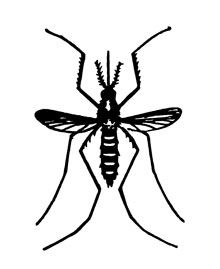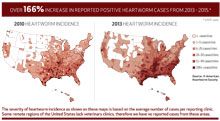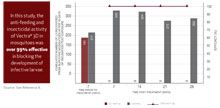A multimodal approach: Add mosquito control to your canine heartworm protocol
Veterinarians diligently recommend and prescribe heartworm preventives to control heartworm disease. Yet, heartworm infection is an ever-increasing problem. Because mosquitoes are the only known vector of Dirofilaria immitis, controlling mosquitoes through the use of an insecticide like Vectra 3D should help control heartworm transmission much in the same way that targeting vectors has been used successfully to control vector-transmitted diseases in people.

Getty Images
Veterinarians diligently recommend and prescribe heartworm preventives to control heartworm disease. Yet, heartworm infection is an ever-increasing problem. Because mosquitoes are the only known vector of Dirofilaria immitis, controlling mosquitoes through the use of an insecticide like Vectra® 3D should help control heartworm transmission much in the same way that targeting vectors has been used successfully to control vector-transmitted diseases in people.
Recently, a group of veterinary practitioners and parasite researchers gathered together to discuss the problem of heartworm disease in dogs and a new multimodal approach that may help to solve it. (Click here for information on the roundtable moderator and each panelist.)
New research suggests that a multimodal, Double Defense approach-administering Vectra® 3D (dinotefuran/pyriproxyfen/permethrin) plus a macrocyclic lactone-to target both mosquitoes and heartworms provides an additional measure to protect dogs against heartworm disease transmission.
Learn More

Visit FightHeartwormNow.com for more information.
Be sure to visit FightHeartwormNow.com for additional information about heartworm disease and mosquitoes. See Dr. McCall's most recent research results and the new Double Defense heartworm protocol. You can also view video segments from this roundtable and interviews with these roundtable participants.
The spread of heartworm
Dr. Elizabeth Hodgkins (moderator): Monthly oral heartworm products have been around since the 1980s. The incidence of heartworm infection has been rising and spreading-in spite of really good products and really good veterinary care. Why do you believe this is the case?
Dr. C. Thomas Nelson: We are a mobile society, moving across the country, moving to areas that were typically not endemic. When I graduated in 1979, the heartworm map showed a few dots out west. Now California ranks tenth in the nation for number of heartworm cases.
Dr. Nancy Soares: Veterinarians are doing a good job, but we are not making enough headway with this disease. A lot of it falls on the veterinarian in the examination room, talking to owners. As a practitioner myself, I know there is always a lot to talk about with owners, but preventing heartworm disease should start there.
Dr. Nelson: As practitioners, we need to be sure owners understand the importance of giving heartworm preventives every month. I give a lot of talks to veterinarians across the country, and I tell them that my own dog got heartworm disease. I switched from the daily product to a monthly product, and a year later, my dog was positive. I always ask the room-full of veterinarians and technicians-how many of them give their dogs' heartworm prevention every month, never missing a dose and never late by more than a week. Maybe 10% to 20% raise their hands. We know better, and we are not compliant. Yet, we expect owners to be compliant.
Dr. Susan Little: Compliance is a major challenge and one of the key reasons that we still have a high prevalence of infection in dogs. Another concern is that many dogs are never seen by a veterinarian. Those dogs become infected with heartworm and serve as reservoirs to mosquitoes, which go on to infect other dogs. So infection is a constant risk.

Role of mosquitoes
Dr. Little: With changing climate patterns, we have a lot of mosquito activity. And we are confronting more mosquitoes than we did before. More than 70 species of mosquitoes have been confirmed to vector heartworm,1 with as many as 25 species confirmed to harbor infection in the United States.2 * Although not all are considered critical, this creates a greater risk for dogs.
Dr. Robert Wirtz: That represents about 40% of the approximately 180 mosquito species recognized in the United States. Usually only one or two mosquito species are the primary vectors of a specific infection of humans in a geographic region.

For an 8-page PDF of this roundtable proceedings, click here.Dr. Little: It is also clear that while coyotes are a growing concern, domestic dogs are still the main reservoir for heartworm. We see extremely high prevalence rates in dogs in urban areas, which is surprising to many people. Some veterinarians think of heartworm as a rural disease, but it is more efficiently transmitted when dogs are close together because then the mosquito does not have to carry the infection far. Lots of mosquitoes equal lots of efficient transmissions. The prevalence rate of heartworm in shelter dogs in some areas in the South exceeds 50%,3 so there is always an opportunity for a mosquito to find microfilariae and then transmit larvae to another dog just a few weeks later.
Dr. Nelson: Most mosquitoes travel only about 2 km. If you have a heartworm-positive dog in a neighborhood, then 33% of the mosquitoes in the area are infective.4 That makes a big difference.
Dr. Little: Yes, if we look at a community-wide survey of mosquitoes, the infection rate may only be 1% or 2%. But around infected dogs, 50% to 75% of the mosquitoes are carrying larvae and creating a risk of infection.4
Dr. Wirtz: We see that with malaria, too. It can be very focal, based on the human reservoirs, vector behavior, and topography. If we can recognize that, then we can focus our resources on those higher-risk areas.5,6
*Vectra® 3D repels and kills mosquitoes (Culex spp, Ochlerotatus spp, Aedes spp) which may vector heartworm.
Vectra® 3D is a registered trademark of Ceva Animal Health, LLC.
DO NOT USE VECTRA® 3D ON CATS.
Vector control
Dr. Hodgkins: It sounds like there are a variety of challenges that contribute to the spread of heartworm, and many of them seem to focus on the mosquito vector. From a One Health perspective, perhaps it is prudent to consider what we are doing with human vector-borne diseases.
Dr. Wirtz: Vector control has always been at the heart of limiting vector-borne diseases.
Dr. Nelson: The multimodal approach used in human medicine is something we need to embrace more in veterinary medicine. We need to look at how we can decrease exposure to the infection.
Dr. Wirtz: Yes, I think that is the only way forward. The more transmission there is, with parasite exposure to the treatment drug, the quicker resistance is going to develop.7 One way to reduce the development of drug resistance is to control the vector.
Dr. Little: There is a natural attraction to vector control that focuses on protecting the dog from mosquitoes. A vector control product with permethrin can help protect a dog from the misery of being fed upon by multiple vectors, including, of course, mosquitoes, thereby making the dog more comfortable and contributing to its overall well-being. But beyond just repelling these vectors, an insecticide that has the ability to kill 95% of the mosquitoes that come in contact with a treated dog would reduce the population of mosquitoes available to transmit heartworm.
Mosquito-borne diseases are more top of mind for the public than ever before because we are now dealing with the new normal of endemicity of West Nile virus and the introduction of other viruses like the chikungunya and Zika viruses. As long as mosquito-borne infections exist, mosquito control matters.

Double Defense data
Dr. Hodgkins: Dr. McCall, can you speak a bit about your recent research that is the foundation of the new Double Defense standard of care in heartworm control?
Dr. John McCall: Well, I think everyone intuitively knows that if you prevent an insect from biting or if you kill that insect, then you will not have disease transmission. But the main reason we have not taken advantage of that and incorporated it into our veterinary recommendations is that, in the past, we have not had this kind of data showing that a product actually repels and kills mosquitoes and, thus, blocks the transmission of heartworm microfilariae. But, in the past couple of years, we have conducted studies with models to assess the effectiveness of products as repellents and insecticides.
Recently, we conducted a study with two groups of dogs that had circulating Dirofilaria immitis microfilariae. We treated one group with Vectra 3D, and the other group was the untreated control. We exposed these dogs to mosquitoes weekly for four weeks. And we found more than 95% repellency with Vectra 3D for the entire month.8
Dr. Hodgkins: Can you define repellency for us?
Dr. McCall: Repellency is preventing mosquitoes from biting-so anti-feeding. And in our study, Vectra 3D was 95% effective. But, more importantly, it was also effective as an insecticide. So if a mosquito touches the dog, the mosquito is not going to survive. In our study, we found that the insecticidal activity was greater than 95% for the month, and none of the mosquitoes exposed to Vectra 3D-treated dogs developed infective larvae (L3).8 These exciting results show that we can actually block the transmission of the infection to mosquitoes. This type of product can both repel the mosquito and kill it before any infective larvae develop.8
Dr. Hodgkins: And that would have an impact on the local environment of that dog? Say of the household?
Dr. McCall: A mosquito that is killed through its contact with Vectra 3D on a treated dog is no longer available to bite any other dog or any other person or any other pet in the area. So it is a form of insecticidal treatment, as well as a repellent.
Dr. Wirtz: There is a similarity here with the large bed net and indoor residual spray programs we use for malaria control. We get the most effective control when we have a community effect. We try to make sure that all the villagers get their houses sprayed or use a bed net. Not only are they protecting themselves, they are also protecting their neighbors.9

Dr. Little: When we talk about controlling intestinal parasites, we talk about fecal pickup and fecal monitoring and making sure the dogs at the boarding kennel are free of parasite infection. We want to reduce transmission as much as possible. For some reason, we have managed heartworm differently over the years. I find the data that Dr. McCall has generated on preventing heartworm transmission to be incredibly compelling and powerful.
What is so exciting about this research is that it says there is more we can do to help prevent heartworm. We still have to administer the preventive-that is foundational and critical-but we can also reduce the number of mosquitoes feeding on treated dogs. The multimodal approach brings a higher level of care and protection to dogs.

Click here for a larger view of these maps.Dr. Soares: It is compelling research. It is new, and the numbers are exciting. Honestly, we have not had a whole lot of new data to talk about on this topic in the examination room in a long time. Dr. McCall's research gives us the opportunity to talk about heartworm prevention and parasite control again. Patients should be receiving an oral heartworm preventive-that is key. They should also receive flea, tick, and mosquito control. But now we can talk about the importance of repellency in heartworm control.
Drug resistance
Dr. McCall: In the study, I chose a particular Dirofilaria immitis isolate-the JYD-34 strain, which is resistant to macrocyclic lactones.
Dr. Little: It is the strain we are all afraid of.
Dr. McCall: One of my goals over the past several years has been to come up with a way to help reduce the rate of selection for these resistant strains. To me, this multimodal approach is one way of doing that because the mosquito that has the resistant heartworm parasite is going to be repelled and killed just the same as the mosquito that has the susceptible one.
Dr. Little: When I first saw you present these data, I was reassured by the fact that you chose JYD-34 because it is something veterinarians are concerned about. We know how to protect dogs from heartworm. We prescribe preventives as early as the label allows, and we do everything we can to support compliance throughout that dog's life. We can implement this multimodal approach and administer something that repels and kills mosquitoes in addition to the heartworm preventives, and that could be effective as an additional layer of protection.

Adopting the Double Defense protocol
Dr. Hodgkins: It sounds like you see real scientific and medical value in moving to a Double Defense multimodal heartworm protocol. How do we change behaviors-both dog owners' and the profession's-to adopt this new approach?
Dr. Wirtz: Changing human behavior is a tremendous challenge in public health. Major portions of the Centers for Disease Control and Prevention's programs focus on behavior change and communication.
I think there is a unique opportunity to educate the local news media.
Dr. Soares: Yes, consumer awareness is huge. Owner communication, education, and support are all key. Owners care that the product is efficacious and affordable, and they want to know that it is something that I, their veterinarian, would administer to my pet.
Dr. Little: Another way to raise awareness is to make the data about the prevalence of heartworm local and timely. The Companion Animal Parasite Council provides a tool that can tell you how many cases of heartworm disease have been diagnosed in your county, and you can get monthly updates. Technicians can put that information on a whiteboard next to the reception desk. That lets owners know it is a risk to their dogs. It underscores the need for heartworm prevention and also the need for mosquito control.
Dr. Wirtz: You might be able to capitalize on the public interest in the chikungunya and Zika viruses by explaining that vector control and personal protection, such as using insect repellents, are the only methods we currently have of reducing these diseases in humans. Similarly, by treating their dogs with Vectra 3D, owners are directly addressing the vector of heartworm transmission.
Dr. Soares: That is a powerful message that we can relay to owners.
Dr. Little: Veterinarians and other team members are already getting questions about Zika virus because there is concern and understandable curiosity about whether dogs are at risk. We do not have any evidence that pets are at risk, but those questions are getting asked. Those questions are a lead-in to the mosquito conversation-an opportunity for team members to say, "We are concerned about mosquitoes, too. Here is what we recommend..."
Dr. Nelson: You have to piggyback on the focus on addressing vector control in humans.
Dr. Wirtz: Yes, there is a lot of public education on mosquito control in general. Again, it is a multicomponent approach. It is a matter of using all of the resources available to kill mosquitoes.

Click for a larger view of this chart.Dr. Little: We have all experienced mosquito pressure firsthand. We all know just how horrible it is, not just for health reasons but also for the lifestyle that people have. People want time in their backyards and their communities. They want their kids outside. There are even data linking childhood obesity to the introduction of Aedes albopictus because it is difficult for children to play outside when mosquitoes swarm them.10 So, for veterinarians, the mosquito concern can serve as a catalyst to start a conversation with dog owners. Educating about the risks mosquitoes create and the steps pet owners can take to reduce those risks is one more way veterinarians can serve their community.
Dr. Soares: I think that is a good way to position it. The research is compelling, and we are not asking owners to change what they are doing. We are just adding the fact that we want owners to reach for a product that has repellency and is mosquitocidal.
Dr. Little: And we are not asking veterinarians to recommend an additional product. If pet owners just administer a flea and tick control product that also repels and kills mosquitoes, then their dogs get another layer of heartworm protection and another layer of comfort.
Heartworm preventive reminders

Click for a larger view of this chart.Dr. Wirtz: It also sounds like reminders could be valuable for pet owners.
Dr. Nelson: There are practice management systems now that can text reminders. We send reminders for heartworm testing-which has higher compliance-but many practices do not send reminders for the monthly preventive.
Dr. Little: There are veterinary pharmacy systems in which heartworm preventive is delivered to an owner once a month and he or she administers it to the pet when it arrives.
Dr. Nelson: So the technology is there. People just need to use it.
Dr. Soares: Our goal is prevention all year long. If an owner purchases six or 12 months of preventives, once it is time that he or she should be running low, we send a reminder, same as we would for an examination or vaccine. We also offer free delivery; anything we can do to make owners' lives easier.
The veterinary team
Dr. Hodgkins: Affecting positive change is going to require a lot of voices talking about Double Defense as a multimodal approach to heartworms. Talk a bit about the role of the veterinary team.
Dr. Soares: Each department has to be involved, and everybody has to care about it. My team cares about our patients-we want these dogs to be happy and healthy. Heartworm disease is a huge problem that we sort of pushed to the side, but we now have the opportunity to open the discussion with owners again. And there are many good talking points, especially with One Health and what is in the news and how people are being affected by their own mosquito-borne disease risks.
Dr. Little: Technicians are key to this conversation. They are already familiar with the heartworm life cycle and with the risk that mosquitoes pose. I think it's important that they reinforce to dog owners that using a product that kills and repels mosquitoes reduces the risk of those mosquitoes feeding on their dogs. This could make a huge difference.
Dr. Hodgkins: What would you want team members to do when an owner comes in to purchase a refill of heartworm preventive?
Dr. Soares: This situation is an opening for a conversation. If we, as veterinarians, have done our job and educated team members about the products and what is best for patients and their families, then there is going to be a dialogue: "I know you are here to refill the heartworm preventive. What about the topical flea, tick, and mosquito preventive? I see that you have not refilled it."
Dr. Nelson: That is an opportunity to review the patient's record. Instead of just refilling the preventive, team members should ask when was the last time it was refilled? And how many doses has the patient received in the past 12 months? What other products is the owner giving the patient? Is the patient up to date on its immunizations?
Dr. Hodgkins: And would Double Defense become part of that checklist for dog owners?
Dr. Nelson: Definitely.
Dr. Soares: As a veterinarian, I think my job is to offer whatever the standard of care is. Pet owners are seeking answers from us, and they listen to our recommendations. I think the Double Defense message is compelling and would be well received. So I would want my team to reiterate this message.

Beyond prevention
Dr. Little: What about when we have an infected dog that has been diagnosed with heartworm infection? If the dog is microfilaremic, in addition to receiving a heartworm adulticide, doxycycline, and a macrocyclic lactone, shouldn't this dog also be administered a product that repels and kills mosquitoes so that any microfilariae in the dog do not get ingested by a mosquito, which a few weeks later feeds on that same dog or another dog? It may be that this strategy should become a primary component of the treatment of every heartworm-infected dog.
Dr. Wirtz: It is actually a no-brainer.
Dr. Nelson: It makes sense, and I support anything we can do to reduce the numbers.
Dr. Little: So would you change the way you treat a heartworm-positive, microfilaremic dog, making sure that it receives a product that repels and kills mosquitoes?
Dr. Soares: I will, absolutely.
Dr. Little: Some pet owners just want to protect their own dogs and are not worried about their neighbors' dogs. So it might be good to reinforce to owners that the mosquitoes that feed on their dogs and ingest microfilariae could come back a few weeks later and reinfect that same dog. There is a cycle of infection.
Dr. Nelson: It is as simple as that, thinking about all the dogs that are at risk.
Dr. Little: Yes, the dog that is infected with heartworms also has to be protected from mosquitoes. Otherwise, the whole community is at risk.
A Strategic Move
Canine heartworm disease is a life-threatening parasitic infection that veterinarians and dog owners continue to battle. Heartworm infection is considered the most important vector-borne disease of dogs in the United States and, as such, it remains of utmost importance to add new research and learning to the existing knowledge base and to look for new solutions and approaches to stop the increasing prevalence.
Ceva Animal Health would like to thank Dr. John W. McCall for his groundbreaking study and all of the practitioners and parasite researchers that participated in this roundtable for sharing their expertise and views on the new Double Defense multimodal approach.
For information on each of the roundtable panelists and moderator, click here.
REFERENCES
1. Otto GF, Jachowski LA, 1981; as cited in McCall JW, Genchi C, Kramer LH, et al. Heartworm disease in animals and humans.
Adv Parasitol. 2008; 66:193-285.
2. Ledesma N, Harrington L. Mosquito vectors of dog heartworm in the United States: vector status and factors influencing transmission efficiency. Top Comp Anim Med. 2011; 26(4):178-185. doi: 10.1053/j.tcam.2011.09.005.
3. Courtney CH, Zeng Q-Y. Comparison of heartworm antigen test kit performance in dogs having low heartworm burdens. Vet Parasitol. 2001; 96:317-322.
4. McKay T, Bianco T, Rhodes L, et al. Prevalence of Dirofilaria immitis (Nematoda: Filarioidea) in mosquitoes from northeast Arkansas, the United States. J Med Entomol. 2013; 50:871-878.
5. Carter R, Mendis KN, Roberts D. Spatial targeting of interventions against malaria. Bull WHO. 2000; 78(12):1401-1411.
6. Githeko AK, Ayisi JM, Odada PK, et al. Topography and malaria transmission heterogeneity in western Kenya highlands: prospect for focal vector control. Malaria J. 2006; 5:107-114.
7. Anderson TJC, Roper C. The origins and spread of antimalarial drug resistance: Lessons for policy makers. Acta Tropica. 2005; 94:269-280.
8. McCall JW, Hodgkins E, Varloud M, et al. Inhibition of the transmission of Dirofilaria immitis to mosquitoes by weekly exposure of microfilaremic dogs treated topically with dinotefuran-permethrin-pyriproxyfen to uninfected Aedes aegypti, in Proceedings 60th Ann Meet Amer Assoc Vet Parasitol 2015; Abstract No. 7; 60.
9. Hawley WA Phillips-Howard PA, TerKuile FO, et al. Community-wide effects of permethrin-treated bed nets on child mortality and malaria morbidity in Western Kenya. Am J Trop Med Hyg. 2003;68(4) Suppl.:121-127.
10. Worobey J, Fonseca DM, Espinosa C, et al. Child outdoor physical activity is reduced by prevalence of the Asian tiger mosquito, Aedes albopictus. J Am Mosq Control Assoc. 2013; 29(1):78-80.